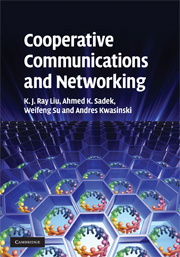Book contents
- Frontmatter
- Contents
- Preface
- Part I Background and MIMO systems
- Part II Cooperative communications
- 4 Relay channels and protocols
- 5 Cooperative communications with single relay
- 6 Multi-node cooperative communications
- 7 Distributed space–time and space–frequency coding
- 8 Relay selection: when to cooperate and with whom
- 9 Differential modulation for cooperative communications
- 10 Energy efficiency in cooperative sensor networks
- Part III Cooperative networking
- References
- Index
8 - Relay selection: when to cooperate and with whom
from Part II - Cooperative communications
Published online by Cambridge University Press: 06 July 2010
- Frontmatter
- Contents
- Preface
- Part I Background and MIMO systems
- Part II Cooperative communications
- 4 Relay channels and protocols
- 5 Cooperative communications with single relay
- 6 Multi-node cooperative communications
- 7 Distributed space–time and space–frequency coding
- 8 Relay selection: when to cooperate and with whom
- 9 Differential modulation for cooperative communications
- 10 Energy efficiency in cooperative sensor networks
- Part III Cooperative networking
- References
- Index
Summary
In this chapter, we present a cooperative protocol based on the relay-selection technique using the availability of the partial channel state information (CSI) at the source and the relays. The main objective of this scheme is to achieve higher bandwidth efficiency while guaranteeing the same diversity order as in a conventional cooperative scheme. Two cooperation scenarios are addressed: a single-relay scenario and a multi-relay scenario. In the single-relay scenario, the focus is to answer the question: “When to cooperate?” The rationale behind this protocol is that there is no need for the relay to forward the source's information if the direct link, between the source and destination, is of high quality. It turns out that an appropriate metric to represent the relay's ability to help is a modified version of the harmonic mean function of its source–relay and relay–destination instantaneous channel gains. The source decides when to cooperate by taking the ratio between the source–destination channel gain and the relay's metric and comparing it with a threshold, which is referred to as the cooperation threshold. If this ratio is greater than or equal to the cooperation threshold, then the source sends its information to the destination directly without the need for the relay. Otherwise, the source employs the relay in forwarding its information to the destination as in the conventional cooperative scheme.
- Type
- Chapter
- Information
- Cooperative Communications and Networking , pp. 278 - 305Publisher: Cambridge University PressPrint publication year: 2008



